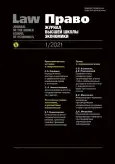The Legal Status of International Organizations as Third Parties to International Treaties in Accordance to Principle pacta tertiis nec nocent nec prosunt
- 作者: Balkhayeva S.1, Pomazansky A.2
-
隶属关系:
- Department of Foreign Constitutional, Administrative, Criminal Legislation and International Law, Institute of Legislation and Comparative Law under the Government of the Russian Federation
- Department of Constitutional law, Institute of Legislation and Comparative Law under the Government of the Russian Federation
- 期: 卷 14, 编号 1 (2021)
- 页面: 154-173
- 栏目: Law in the Modern World
- URL: https://journal-vniispk.ru/2072-8166/article/view/318098
- DOI: https://doi.org/10.17323/2072-8166.2021.1.154.173
- ID: 318098
如何引用文章
全文:
详细
作者简介
Sayana Balkhayeva
Department of Foreign Constitutional, Administrative, Criminal Legislation and International Law, Institute of Legislation and Comparative Law under the Government of the Russian Federation
Email: sayanabb@gmail.com
Leading Researcher, Candidate of Juridical Sciences
Andrey Pomazansky
Department of Constitutional law, Institute of Legislation and Comparative Law under the Government of the Russian Federation
Email: mr_a@mail.ru
Leading Researcher, Candidate of Juridical Sciences
参考
- Antsilotti D. (1961) Course of International Law. Vol. 1. Moscow: Izdatel'stvo inostrannoy literaturu, 447 p. (in Russian)
- Blokker N., Schermers H. (2003) International Institutional Law. Boston — Leiden: Martinus Nijhoff, 1302 p.
- Bordin F. (2018) The Analogy between States and International Organizations. Cambridge: University Press, 276 p.
- Brolmann C. (1998) The 1986 Vienna Convention on the Law of Treaties — The History of Draft Article 36bis. Collection of Essays. The Hague: Martinus Nijhoff, 204 p.
- Charter of the United Nations. A Commentary (2002). Vol. II. Simma B. (ed.). Oxford: University Press, 1258 p.
- D'Argent P. (2011) Article 37. The Vienna Conventions on the Law of Treaties: A Commentary. Corten O., Klein P. (eds.). Oxford: University Press. 2176 p.
- Dailler P., Pellet A. (eds.) (1999) Droit international public. 6th ed. Paris: LGDJ, 1455 p. (in French)
- Dörr O., Schmalenbach K. (eds.). Berlin: Springer, 1534 p.
- Gaja G. (1987) A «New» Vienna Convention on Treaties between States and International Organizations or between International Organizations: A Critical Commentary. British Yearbook of International Law, vol. 58, pp. 253-269.
- Grewe W. (1992) Fontes Historiae Juris Gentium — Sources Relating to the History of the Law of Nations. Berlin: Freie Universität, 682 p.
- Kalamkaryan R.A. (1989) Time Factor in the Law of International Treaties. Moscow: Nauka, 176 p. (in Russian)
- Klabbers J. (2009) An Introduction to International Institutional Law. 2nd ed. Cambridge: University Press, 360 p.
- Manin P. (1986) La Convention de Vienne sur le droit des traités entre États et organisations internationales ou entre organisations internationals. Annuaire français de droit international, pp. 454-473.
- Modern Concepts of Applying International Treaties (2020) A.Y. Kapustin (ed.). Moscow: Norma, 224 p. (in Russian)
- Proelss A. (2018) Article 37. Vienna Convention on the Law of Treaties: A Commentary.
- Reuter P. (1995) Introduction au droit des traits. Paris: Presses univ. de France, 211 p.
- Seyersted F. (2008) Common Law of International Organizations. Leiden: Martinus Nijhoff, 604 p.
- Talalaev A.N. (1997) Vienna Convention on Law of Treaties. Moscow: Yuridicheskaya literatura, 332 p. (in Russian)
- The Law of Treaties beyond the Vienna Convention (2011) Cannizzaro E. (ed.). Oxford: University Press, 496 p.
- Ul'yanova N.N. (1981) General Multilateral Treaties in Contemporary International Relations: Theory Issues. Kiev: Naukova dumka, 259 p. (in Russian)
- Vaurs-Chaumette A. (2005) Commentaire de l'Article 98. La Charte des Nations Units. Commentaire article par article. Cot J., Pellet A., Forteau M. (eds.). Vol. II. Paris: Economica, 2251 p.
补充文件








